The 'PWJ' (post war jet) arena.
Post WWII jet fighters (including those developed during the war that never saw air to air dog fighting with enemy aircraft during WWII). These would also be gun equipped with such as their main armament. :
Dassault Ouragan - France

First flight 28 February 1948
Introduction 1952
Produced 1948-1954
Number built Over 567
Guns: 4× 20 mm Hispano-Suiza HS.404 cannon with 125 rounds per gun
Rockets: 16× 105 mm (4.1 in) Brandt T-10 air-to-ground unguided rockets; or, 2× Matra rocket pods with 18× SNEB 68 mm rockets each
Bombs: 2,270 kg (5,004 lb)) of payload on four external hardpoints, including a variety of unguided iron bombs such as 2× 227 kg (500 lb) bombs or 2× 458 l (121 US gal; 101 imp gal) napalm bombs / Drop tanks for extended range.
https://en.wikipedia.org/wiki/Dassault_Ouragande Havilland Vampire - United Kingdom

First flight 20 September 1943
Introduction 1946
Number built 3,268
Guns: 4 × 20 mm (0.79 in) Hispano Mk.V cannon with 600 rounds total (150 rounds per gun).
Rockets: 8 × 3-inch "60 lb" rockets
Bombs: 2 × 500 lb (225 kg) bombs or two drop-tanks
https://en.wikipedia.org/wiki/De_Havilland_VampireHawker Sea Hawk - United Kingdom

First flight 2 September 1947
Introduction March 1953
Royal Netherlands Navy (retired)
Number built 542
Guns: 4 × 20 mm (0.787 in) Hispano Mk.V cannon with 200 rpg
Hardpoints: 6 underwing with provisions to carry combinations of:
Rockets: 20 × RP-3 "60 lb" (27 kg) unguided rockets or 16 × 5 in (127 mm) unguided rockets
Bombs: 4 × 500 lb (227 kg) bombs
Other: or 2 × 90 imp gal (108 US gal; 409 l) drop-tanks
https://en.wikipedia.org/wiki/Hawker_Sea_HawkSupermarine Attacker - United Kingdom

First flight 27 July 1946
Introduction August 1951
Number built 182 + 3 prototypes
Guns: 4 × Hispano No. 3 Mark 5 20mm Cannon
https://en.wikipedia.org/wiki/Supermarine_AttackerSupermarine Swift - United Kingdom

First flight 29 December 1948 (Type 510)
Introduction 1954
Number built 197
Guns: 2 × 30 mm (1.181 in) ADEN cannon
Rockets: provisions for rockets
Bombs: provisions for bombs
https://en.wikipedia.org/wiki/Supermarine_SwiftBell P-59 Airacomet - United States

First flight 1 October 1942
Number built 66
1x 37 mm M10 autocannon with 44 rounds of ammunition
3x .50 cal (12.7 mm) AN/M2 Browning heavy machine guns with 200 rounds per gun
Rockets: 8× 60 lb (30 kg) rockets
Bombs: 2,000 lb (910 kg) bombs
https://en.wikipedia.org/wiki/Bell_P-59_AiracometLockheed P-80 Shooting Star - United States

First flight 8 January 1944
Introduction 1945
Number built 1,715
Guns: 6 × 0.50 in (12.7mm) M3 Browning machine guns (300 rpg)
Rockets: 8 × 127 mm (5.00 in) HVAR unguided rockets
Bombs: 2 × 1,000 lb (450 kg) bombs
https://en.wikipedia.org/wiki/Lockheed_P-80_Shooting_StarMcDonnell FH Phantom - United States

First flight 26 January 1945
Introduction August 1947
Number built 62
Guns: 4 × .50 in (12.7 mm) machine guns
Rockets: 8 × 5 in (127 mm) High Velocity Aircraft Rockets
https://en.wikipedia.org/wiki/McDonnell_FH_PhantomRyan FR Fireball - United States
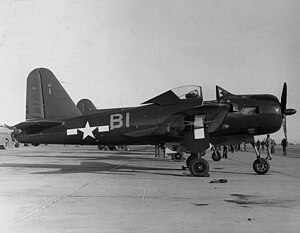
First flight 25 June 1944
Introduction March 1945
Number built 71
Guns: 4 × .50 in (12.7 mm) M2 Browning machine gun with 300 rpg
Rockets: 8 × 5-inch (127 mm) rockets under wings
Bombs: 2 × 1,000 lb (454 kg) bombs
https://en.wikipedia.org/wiki/Ryan_FR_FireballMikoyan-Gurevich MiG-9 - Soviet Union
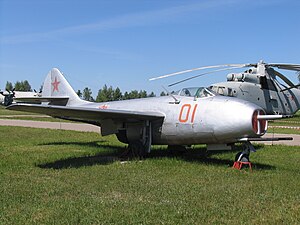
First flight 24 April 1946
Produced 1946–1948
Number built 598 (including 12 prototypes)
1 × 37 mm (1.457 in) Nudelman N-37 autocannon extending from nose intake divider
2 × 23 mm (0.906 in) Nudelman-Suranov NS-23 autocannon extending from undersides of nose intake
https://en.wikipedia.org/wiki/Mikoyan-Gurevich_MiG-9Yakovlev Yak-15 - Soviet Union

First flight 24 April 1946
Introduction 1947
Produced 1946–47
Number built 280
Guns: 2 × 23 mm Nudelman-Suranov NS-23 cannon with 60 rounds each
https://en.wikipedia.org/wiki/Yakovlev_Yak-15Yakovlev Yak-17 - Soviet Union

First flight June 1947
Introduction 1948
Produced 1948–1949
Number built 430
Guns: 2 × 23 mm (0.91 in) Nudelman-Suranov NS-23K autocannon with 105 rounds per gun
https://en.wikipedia.org/wiki/Yakovlev_Yak-17Grumman F9F Panther - United States
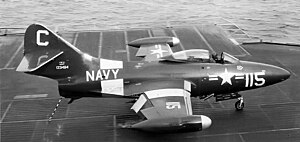
First flight 21 November 1947
Retired 1958, U.S. Navy
1969, Argentina
Number built 1,382
Guns: 4 × 20 mm cannon
https://en.wikipedia.org/wiki/Grumman_F9F_PantherRepublic F-84 Thunderjet - United States

First flight 28 February 1946
Introduction November 1947
Retired 1964 (USAF)
1974 (Yugoslavia)
Number built 7,524
6 × .50 in (12.7 mm) M3 Browning machine guns, 300 rpg
Up to 4,450 lb (2,020 kg) of rockets and bombs
https://en.wikipedia.org/wiki/Republic_F-84_ThunderjetRepublic F-84F Thunderstreak - United States

First flight June 3, 1950
Introduction May 12, 1954
Retired 1972 (US ANG)
1991 (Greece)
6× .50 in (12.7 mm) Browning M3 machine guns, four mounted in nose over intake, two mounted in the wing roots, 1,800 rounds
Up to 6,000lb (2,727 kg) of rockets and bombs
https://en.wikipedia.org/wiki/Republic_F-84F_ThunderstreakDassault Mystère - France
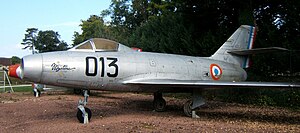
First flight 23 February 1951
Introduction 1954
Retired 1963 (France)
Guns: 2× 30 mm (1.181 in) DEFA cannon with 150 rounds per gun
Rockets: 2× Matra rocket pods with 18× 68 mm (2.68 in) SNEB rockets each
Bombs: 900 kg (2,000 lb) of payload on four external hardpoints, including a variety of bombs or Drop tanks
https://en.wikipedia.org/wiki/Dassault_Myst%C3%A8reDassault Mystère IV - France

First flight 28 September 1952
Produced 1953–1958
Number built 411
Guns: 2× 30 mm (1.18 in) DEFA cannons with 150 rounds per gun
Rockets: 55 air-to-air rockets in retractable pack[16]
Bombs: 1,000 kg (2,200 lb) of payload on four external hardpoints, including a variety of bombs, rockets or Drop tanks
https://en.wikipedia.org/wiki/Dassault_Myst%C3%A8re_IVSaab 21R - Sweden
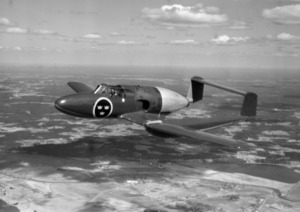
First flight 10 March 1947
Introduction 1950
Retired 1956
1× 20 mm akan m/45 with 140 rounds in the nose
2x 12.7 mm (0.50 in) akan m/39A with 350 rpg in the nose
2x 12.7 mm (0.50 in) akan m/39A with 325 rpg in the wings
(The J 21RA had 13.2 mm barrels installed on its akan m/39A's but these were changed to 12.7 mm once they were converted to A 21RA)
Belly 700 kg (1,543 lb) maximum
Vapenkapsel paddan "the toad" gunpod containing 8x 8 mm ksp m/22 machine guns with 800 rounds per gun
10x 8 cm pansarraket m/46 AP-rocket (RP-3 rocket with Shot, 25 lb., "AP" Mk II head)
10x 15 cm sprängraket m/46 HE-rocket (RP-3 rocket with Shell, H.E. 60 lb., "SAP" No. 2 Mk Ihead)
10x 14,5 cm pansarsprängraket m/49A & B HEAT-rocket (Bofors 10.3 cm rocket with 14,5 cm HEAT head)
10x 15 cm sprängraket m/51A & B HE-rocket (Bofors 10.3 cm rocket with 15 cm HE head)
5x 18 cm halvpansarraket m/49A & B SAP-rocket (Bofors 18 cm rocket with 18 cm APHE head. At the start used primarily against ships but in the end against basically everything else.)
Wingtips
2x vingspetstank drop tanks (Could be armed in flight as incendiary bombs. They were also tested with napalm.)
https://en.wikipedia.org/wiki/Saab_21R